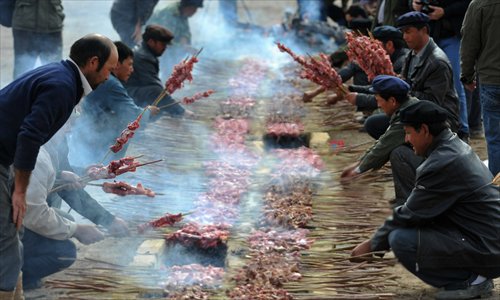HOME >> LIFE
A bite of Xinjiang
Source:Global Times Published: 2014-6-6 5:03:02

People in the Xinjiang Uyghur Autonomous Region cooking mutton skewers. Photo: CFP
The second season of A Bite of China devoted two episodes of the new series released last month to the native dishes of the Xinjiang Uyghur Autonomous Region in Northwestern China, ranking it No.3 as China's best region for food.The popularity and large viewership of the documentary have brought the region's local dishes to greater public attention, with many people from across China buying the food online as the region's cuisine grows in popularity.
A Uyghur university student, Adil Mehmet, who recently opened an online shop selling snacks such as raisins and Maren Sugar, has seen sales soar since the documentary broadcast last month. The daily sales of Uyghur food retailers have grown up to ten times their normal amount in the past month, some earning a daily revenue of over 100,000 yuan ($16,000), according to a report by the Xinhua News Agency.
The strong taste of the food in Xinjiang is making a deep impression in people's memory. The sweetness and attractive smells of its cuisine are seen as being reflective of daily life in the region: passionate, straightforward and full of sunlight.
Sweetest place
Located in the center of the Turpan Basin, west of Urumqi, Turpan Prefecture endures long hot summers. It is famously known as the setting in the story Journey to the West, where the Monkey King borrows the giant palm-leaf fan to extinguish the fire from the Flaming Mountains.
The harsh cold desert climate of the region creates a noticeable weather contrast between day and night, which plays a helpful role with vegetation in the region. Rich sunlight, accompanied with a nightly temperature drop and an abundant underground water supply, makes an environment rich with fruits.
There are over 210 hectares of grapery in Turpan, producing over 6 million kilograms of fresh grapes and over 300 tons of raisins each year. The fresh grapes are usually served from July to October, and placed in dry shelves shaded from the sun once they have ripened.
During other months of the year, raisins that are produced are sold at home and abroad. Raisins in the region contain only about 15-25 percent water but about 60 percent of fructose, hence their poignant sweet taste. Raisins are not only eaten as a separate snack, but widely used in desserts and other local dishes, such as pilaf.
The region's grapes offer juice for another local desert, Maren Sugar (Xinjiang nut cake), or as people outside of the Xinjiang Uyghur Autonomous Region call it, qiegao. Along with local walnuts, sesame and other optional sauces such as raisins, rose, peanuts and dates, grape juice holds all the ingredients of the desert tightly together, making the sugar become hard with a delicious thick density.
Maren Sugar can also be preserved for long periods of time, similar to the selected dry fruits of the region, which explains why these foods rich in energy were the snacks of choice amongst Silk Road merchants for centuries.
Roasting legends
One of the most mouthwatering Chinese dishes comes from the Xinjiang Uyghur Autonomous Region, the famed mutton kebab.
Unlike kebabs in other countries, Xinjiang mutton kebab is served on a skewer, which Chinese people call a mutton skewer, or in Chinese, chuan'er.
Mutton skewer could very much be the favored street snack of choice throughout China, or at least the most common delicacy presented to honored guests on formal occasions.
The proper cooked mutton kebab is brown and glossy, sprinkled with salt, cumin, and dried red pepper, giving it a rich and tender taste.
In the preparation of the mutton, all meat is cut into thin slices with several pieces of both fat and lean meat skewered with either a wooden or metal stick. The sticks used for skewing the mutton are traditionally made from branches of rose willow which is rarely used today.
When all skewers are ready, they are placed on the flame stove which is then fanned so both sides of the mutton is roasted evenly. Ingredients are then sprinkled on both sides and it is ready to be served.
In recent years, a new kind of mutton kebab has become popular called the "meter kebab," which is nearly one meter long and equals close to seven or eight normal skewers.
If the "meter kebab" cannot satisfy the needs of meat-lovers, then a whole roast lamb is the next best choice.
The whole roast lamb of Xinjiang is famous not just for the carefully picked ingredients, but also the unique process of cooking it. The lambs used are usually less than a year old, with their meat covered in a blend of paste, flour, salt water, eggs, turmeric, cumin and pepper. The whole lamb is then skewered on a large stick and roasted in a Nang pit for up to an hour.
Considered the best possible dish among Uyghur people, once the whole roast lamb is cooked, it is then served to guests on a trolley, often presented with a colored silk tie wrapped around the head of the lamb.
Fortunately, most authentic Xinjiang food is no longer limited to just the region itself. The recent surge of Uyghur people moving to other areas of China means more Xinjiang restaurants can be found today in most cities. Mutton kebab has become not only one of the most favored Chinese foods among Chinese people, but among many foreigners too as Xinjiang's food continues to win fans.
Newspaper headline: A tasty glimpse into the cuisine of Northwestern China
Posted in: Food